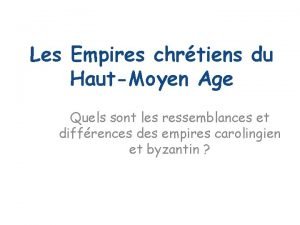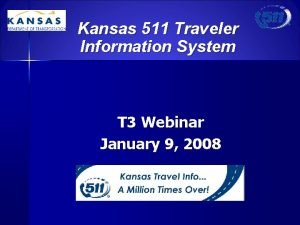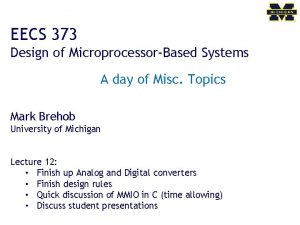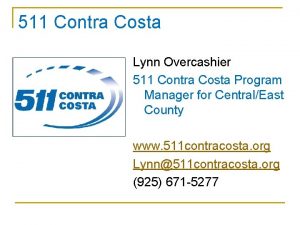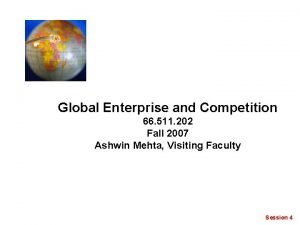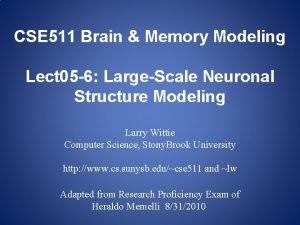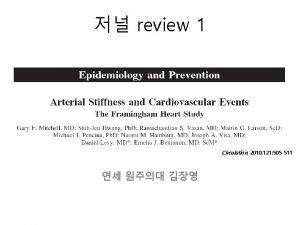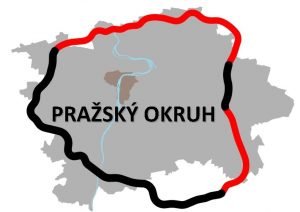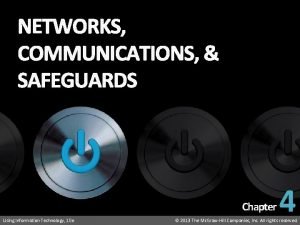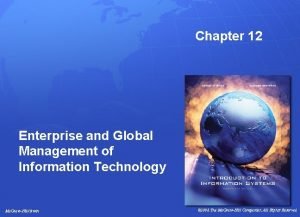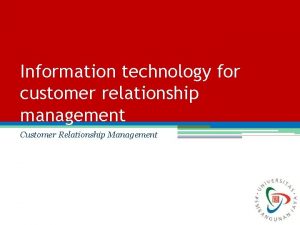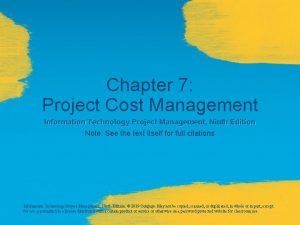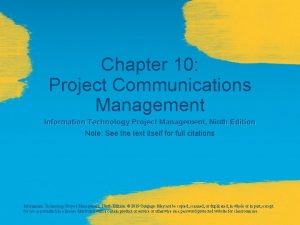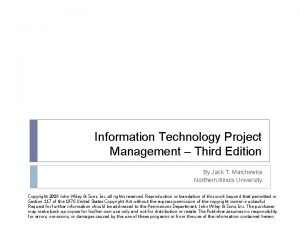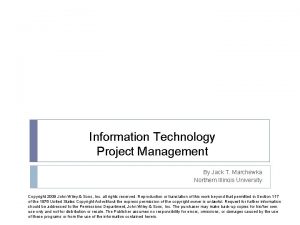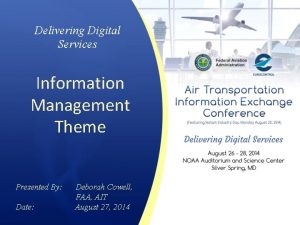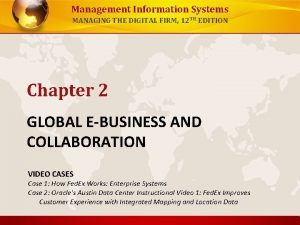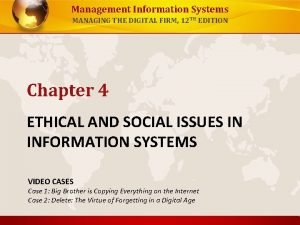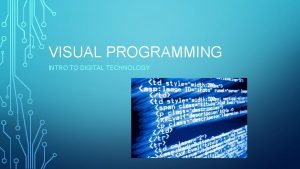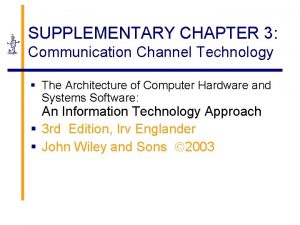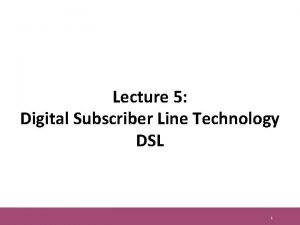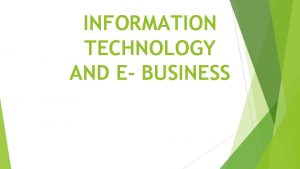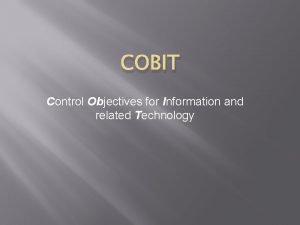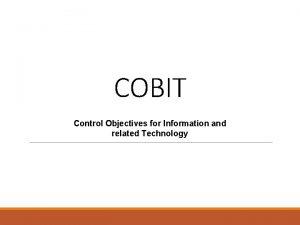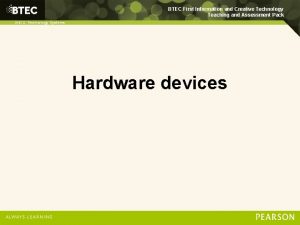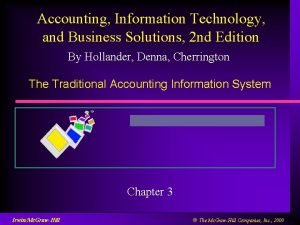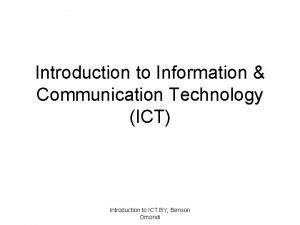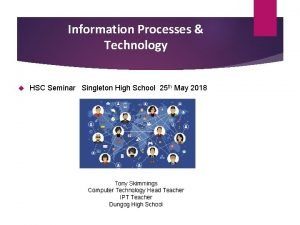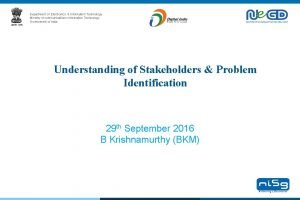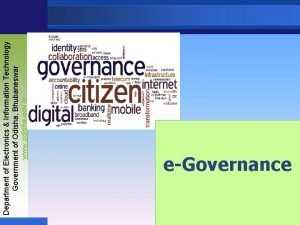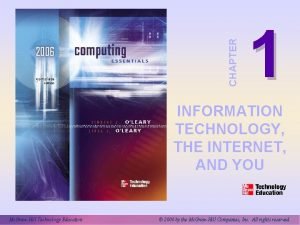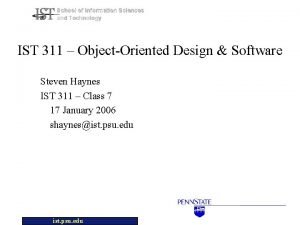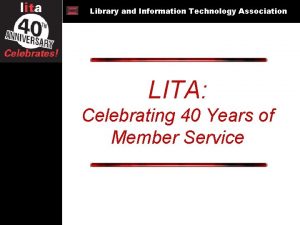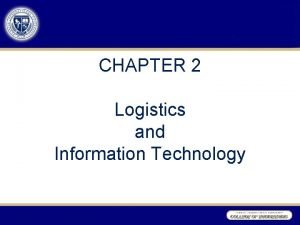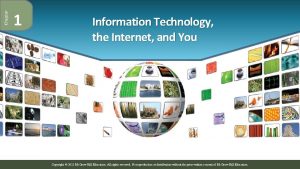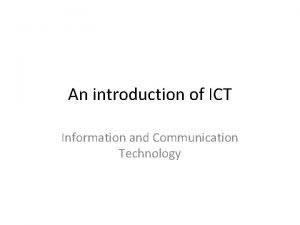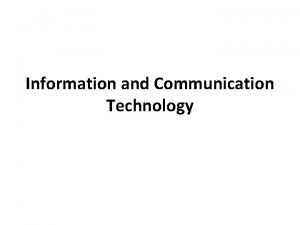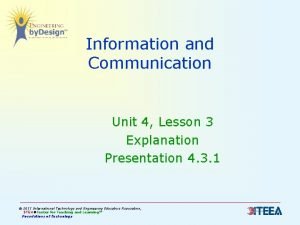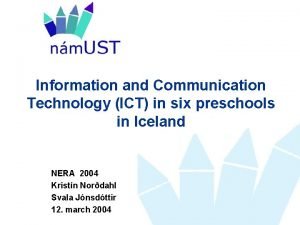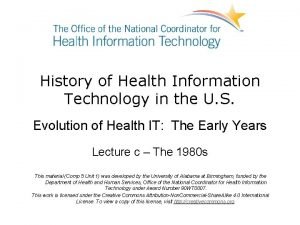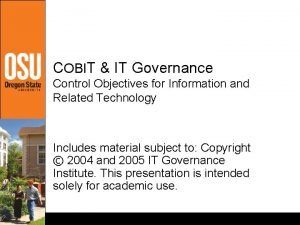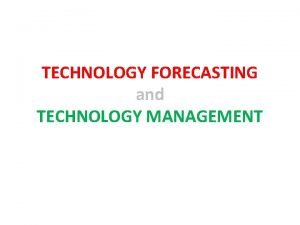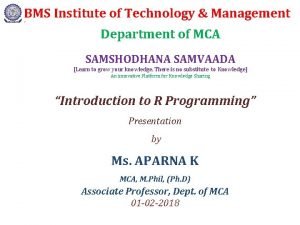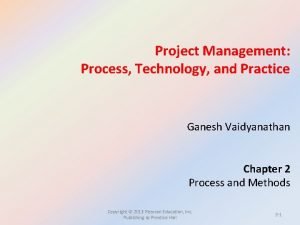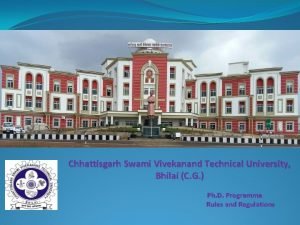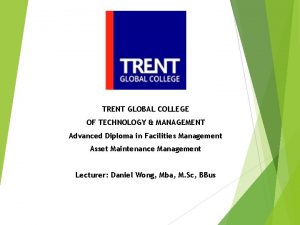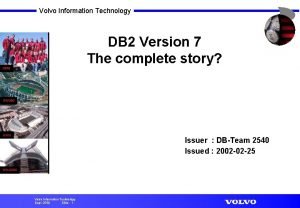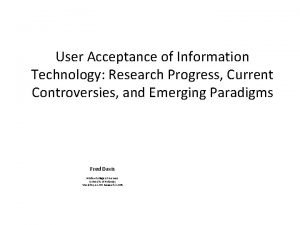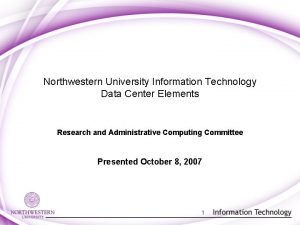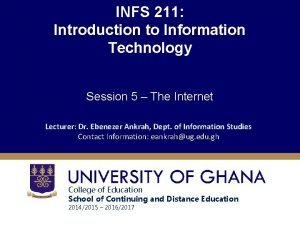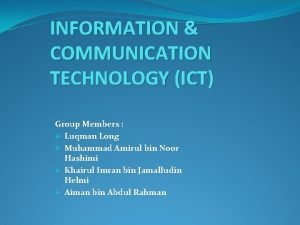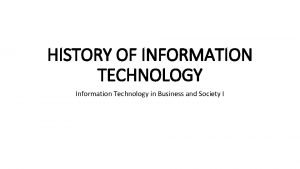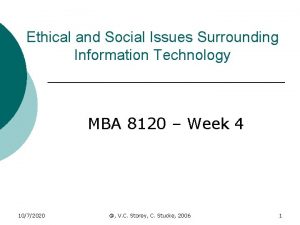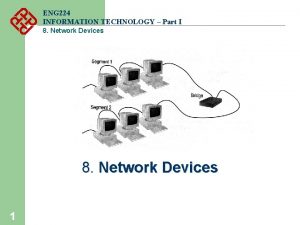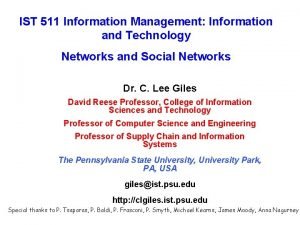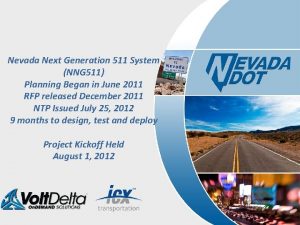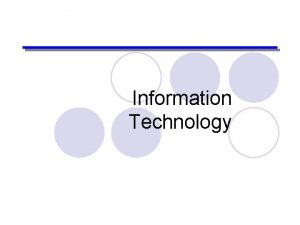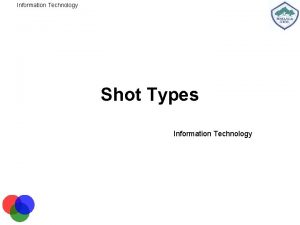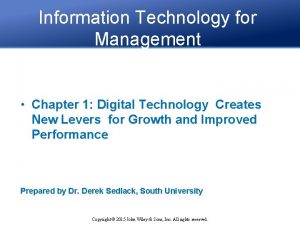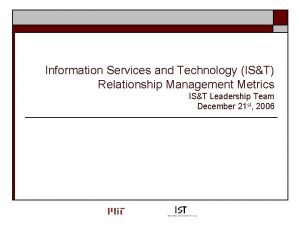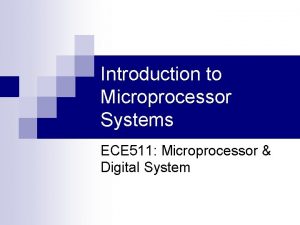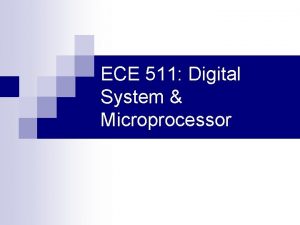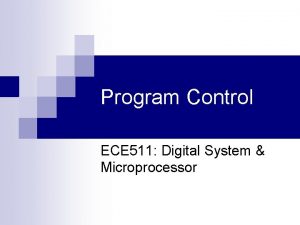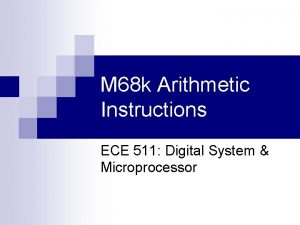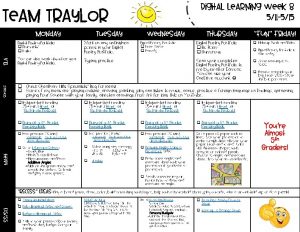IST 511 Information Management Information and Technology Digital

















































































![Induction [General research question] Observation Theory Formulation Induction [General research question] Observation Theory Formulation](https://slidetodoc.com/presentation_image_h2/48605c9919352cfc7d1635881d2e20d7/image-82.jpg)








- Slides: 90

IST 511 Information Management: Information and Technology Digital Humanities and Research Methods Dr. C. Lee Giles David Reese Professor, College of Information Sciences and Technology Professor of Computer Science and Engineering Professor of Supply Chain and Information Systems The Pennsylvania State University, University Park, PA, USA giles@ist. psu. edu http: //clgiles. ist. psu. edu Special thanks to V. Ryabov,

Today What are the digital humanities What are research methods – Qualitative – Quantitative – Computational Last time: • Digital libraries • Scientometics and bibliometrics

Tomorrow Your research presentations

Digital Humanities Other names for the digital humanities • Computational humanities • Computational archaeology • Computational history • etc • Cultural informatics

Digital Humanities

Humanities What are the humanities? Wikipedia Stanford National Endowment for the Humanities (NEH)

History of the Digital Humanities Not that old – 1940’s – start of digitization

“Digitus Dei est hic!” http: //www. corpusthomisticum. org/it/index. age

Hockey’s Consolidation 1970’s –mid-1980’s

New Developments Mid 1980’s –early 1990’s http: //www. tei-c. org/index. xml

http: //www. perseus. tufts. edu/hopper/

Web/Humanities 1. 0: From the few to the many Web/Humanities 2. 0: From the many to the many

http: //vos. ucsb. edu/ http: //nines. org/

Film and Media and Communication Studies Film Media Communication Cultural Feminist STS http: //www. manovich. net/

Explosion of new groups, communities, subjects

The Disciplines Literary Studies Archeology Art History Classical Studies History Is this all? The Arts

Archeology http: //www. cast. uark. edu/other/nps/nadb/ http: //www. u. arizona. edu/~mlittler/ http: //www. cast. uark. edu/

Art History and The Arts http: //www. vraweb. org/ http: //users. ecs. soton. ac. uk/km/projs/ vasari/ http: //www. getty. ed u

Classical Studies • Obsolescence and Preservation http: //scriptorium. lib. duke. edu/papyrus/ http: //nolli. uoregon. edu/rioni. html Problematics http: //www. romereborn. virginia. edu/

History http: //valley. vcdh. virginia. edu/ http: //ahsp. cuny. edu Accessibility

Teaching and Learning New Learning Environments New Subjects New Pedagogies Digital Disconnect

Literary Studies What happens to lit and “literary” in the age of digital tech? http: //www. emilydickinson. org/ http: //www. rossettiarchive. org/ http: //ted. streamguys. net/ted_rives_mockingbirds_2006. mp 3

Thematic of Textuality vs. Visuality Jerome Mc. Gann‘: digital technology and literary studies written (and published) between 1993 and 2001. Episodes in the history of Mc. Gann's engagement with the intellectual opportunities offered by the interaction between computer power, digital technology and literary Richard Mayer: For hundreds of years verbal messages have been the primary means of explaining ideas to learners. Although verbal learning offers a powerful tool for humans, this book explores ways of going beyond the purely verbal

Teaching and Learning Digital Disconnect Electracy Oral Print Electronic

Examples http: //www. vectorsjournal. org/issues/index. php? issue=5 http: //vectors. usc. edu/issues/05_issue/bluevelvet/ http: //www. vectorsjournal. org/index. php? page=7&project. Id=86

Wayne State Digital http: //www. lib. wayne. edu/resources/digital_library/index. php

Social Networks

From Remediation to Convergence and Intermediation

HASTAC http: //www. hastac. org/

Digital Antiquity - Mission Organization devoted to enhancing preservation and access to digital records of archaeological investigations – to permit scholars to more effectively create and communicate knowledge of the long-term human past; – to enhance the management of archaeological resources; and – to provide for the long-term preservation of irreplaceable records of archaeological investigations.

We’re Losing the Archaeological Record Explosion of Digital Information – >50, 000 field projects/year, 1000 s of databases – Primary archaeological data is now “born digital” Absence of Trusted Repositories – Few institutions capable of long-term data curation – Media on which data resides is treated as an artifact – Standard work flows do not move digital data into trusted repositories Fragility of Digital Data – Media degradation & software obsolescence – Loss of data semantics (metadata) We need a trusted digital repository for archaeological documents and data

Digital Antiquity’s Repository: t. DAR - the Digital Archaeological Record On-line, trusted digital repository for archaeological data and documents that – financially and socially sustainable, – long-term preservation of data & metadata – on-line discovery, and access for data and documents produced by archaeological projects. – web ingest interface: acquire metadata and user upload of data Scope – targets digital products of ongoing research & legacy data – focus on archival data (not continuously updated databases such as site files) – Work of scholars in the US and the Americas more broadly

Digital Antiquity Builds on the ADS Model The Archaeology Data Service (ADS) in the UK has a 10 year track record of success – ADS is heavily staffed (ca 10 FTE), provides a high level of curation and high quality archive – ADS provides a refined presentation layer for its projects – ADS processes a relatively small number of projects (ca 200) each year at a high unit cost

Digital Antiquity Diverges from ADS In Order to Scale to the US Situation 50, 000 federally mandated cultural resource field projects conducted each year in the US. – t. DAR aspires to capture the digital data and documents from a substantial fraction Implies a different business model Demands much heavier reliance on users to provide metadata that make their data meaningful Requires a user-friendly ingest interface for metadata acquisition and data upload

Prototype Ingest Interface

Preservation and Access Requirements To maintain the utility of data, we must preserve the data (bits) on a sustainable media, in a sustainable format, along with their semantics – Existing coding keys and manuals are inadequate Cannot require universal coding schemes – We must employ ontologies to allow naive users to locate relevant resources. We must plan for integration of data that employ different systematics. – We must collect detailed database metadata (e. g. , at the table, column, and value level) Need persistent URIs, DOIs

Metadata & Database Semantics Standardization of original data on deposit is unacceptable – We must capture, not transform, original semantics – Digital coding sheets at dataset registration time Our representation is not highly abstract but structured by archaeological practice On registration, the dataset creator – associates database codes with dataset labels through a coding sheet – and maps coding sheet labels to default (and possible alternate) ontologies created by material class experts

Modeling Global Societal Evolution Over a Half-Century: Petascale Humanities Computing Institute for Computing in the Humanities, Arts, and Social Science at the University of Illinois and Center Affiliate of the National Center for Supercomputing Applications


Research Directions Forecast global stability Model social group interactions Gain a better understanding of the underpinnings of global unrest and how society functions Quantify the flow of information across the world and how human societies produce and consume realtime information Gain new understanding of the evolution of the civil war discourse

The Digital Humanities Very large field, encompasses a tremendous variation in applications Focus on the textually-driven humanities, such as history, journalism, etc

Quantitative Qualitative Computation Digital humanities requires “Quantitative Qualitative Computation” – find ways of converting the “latent” aspects of language into computable numeric indicators Historically have focused on facts and discarded the rest as “uncomputable” More recently, dimensions such as “tone” have become booming industries (brand mining)

Quantitative Qualitative Computation VERY computationally expensive Easy to take Google Ngram dataset and plot frequency of “democrat” vs “republican” in time to see who gets more book coverage each year Gauging which one gets the most POSITIVE coverage, however, and WHERE that coverage comes from requires a LOT of computation

Building a Global Map The map at the start of this presentation visualizes a geographic cross-section through a much larger dataset: a petascale network What does a digital humanities pipeline look like?

Petascale Networks Start with a petascale network 10 billion actors connected by over 100 trillion relationships just from a single dataset covering only 30 years Assuming simple tuple structure: ID, WEIGHT, ID, that’s 8 b * 3 = 24 bytes * 100 trillion rows = 2. 4 PB Need this all memory-resident for random access across the ENTIRE dataset This is just a small pilot dataset Data is XD

From “Big Data” to “Really Big Data”

Is XD really “Big Data? ” Total disk of all current production XD systems combined: 12. 1 PB (Gordon is 1/3 of the entire XD) If we add all XD tape silos, we get 34. 1 PB The entire national allocated research infrastructure is just 12 PB of disk and 22 PB of tape! Microsoft’s Bing search engine uses 150 PB of spinning disk Biggest scientific projects will generate only 10 -20 TB / day of data, while Twitter alone produces 28 GB of new data a day and Bing processes 2 PB / day

“Really Big Data” Traditional sciences are “small data” compared with the information world of news and social media 200 MILLION new tweets a day 1 BILLION new Facebook items a day: average person adds 3 items to Facebook every single day

“Really Big becomes REALLY Big” Social media in particular is vastly outpacing traditional information sources Entire New York Times 1945 -2005 = 18 M articles = 2. 9 billion words 5 BILLION words added to Twitter each DAY (almost twice the total volume of the Times in the last 60 years)

And Even Bigger Haiti. Trust includes Google Books and contains 4% of all books every printed = 9. 4 million digitized works = 3. 3 billion pages = 2 trillion words Estimated 49. 5 trillion words ever printed in books over last 600 years Twitter alone will reach that size in just 27 years with zero additional growth. With its current rate of tripling post volume each year, it will take just three years

Storing and Searching Big Text

The BIG World of Text With scientific datasets, you have data and then you have an index (HDF + Py. Tables) With text the data IS the index Text is vast and operates at the microlevel of the word (equivalent to every query searching every pixel of a vast image archive) Unstructured Tons of associated metadata

What is research? Research work and comparable development work refer to systematic activity to increase the level of knowledge and the use of the knowledge to find new applications. The essential criterion is whether the activity generates fundamental new knowledge. Research could be: basic, applied, and developmental.

Basic research This refers to such activities to gain new knowledge which do not primarily aim to practical applications. Basic research includes, for example, analysis of qualities, structures and dependencies whose objectives are to form and test new hypotheses, theories and scientific regularities. Furthermore, basic research can be also directed, in which the results can be expected to result in significant applications; sometimes, however, only in the long run.

Applied research This refers to such activities to gain new knowledge, which primarily aim to develop specific practical application. The purpose of applied research is to deal with questions of everyday life. Applied research includes, for example, seeking applications for findings of basic research, or creation of new methods and means to solve a specific problem.

Developmental research Uses the knowledge gained from research and/or practical experience to create new materials, products, manufacturing processes, methods and systems or to improve existing ones significantly. It includes, for example, so-called action research which produces information directly in the situation in which it is also applied, and any research and development activities taking place during R&D projects in industry.

Research process Selecting a topic & research questions Selecting research methods Writing a research report/paper/thesis Analyzing data Reading for research Collecting data

When and why to write down? Write to remember Experienced researchers never wait for the end of the project to start writing. They make a list of sources, summaries, keeping lab notes, making outlines, etc. Write to understand When you arrange or rearrange the results of your research in new ways, you can discover new connections, contrasts, complications, and implications. Write to gain perspective The basic reason for writing is to get your thoughts out of your head and onto the paper, where you can see them more clearly.

What is not a scientific research? Investigations, which refer to data gathering, editing, and analyzing for planning or decision processes. Investigations are usually an actual part of the planning process. Gathering of the general information. For example: continuous observations primarily for other reason than the research, such as hydrological weather observations, the production of statistics, opinion polls, archaeological excavations obligated by the law, collecting and arranging documents, market research, inventory and charting of the natural resources. Production of computer applications, unless they are a part of a research project.

Criteria of good research work Fertility. The results of the research pose new questions, reveal new problems and directions for further research. Relevance. Good research is significant and influential. Objectivity. Although researchers can freely define the problems and the hypotheses, the implementation of the method, as well as the results and reporting, must be objective. Verification. It must be possible to examine every research discovery, test result, measurement and interpreted result from the point of view of its validity and relevance. Practicality. Every good study shows opportunities for practical applications.

Ethical questions of research Research is a profoundly social activity. Reporting research connects us not just to those who will use it, but also to those whose research we used. Do not plagiarize or claim credit for the results of others. Do not misreport sources or invent results. Do not submit data whose accuracy there is a reason to question, unless you raised the questions. Do not hide objections you cannot respond to. Do not caricature or distort opposing views. Do not destroy or hide sources and data important for those who follow.

Plagiarism is the worst thing that can happen to a researcher. You plagiarize when, intentionally or not, you use someone else’s words or ideas but fail to credit that person, leading your readers to think that those words are yours. Standards for plagiarism could be different in different fields. Every time you use the exact words of the source: – type quotation marks before and after them – record the words exactly as they are in the source – cite the source

Finding a research topic Your interests General topic Focused topic Research questions

Twelve issues to keep in mind How much choice you have Your motivation The time you have available Regulations and expectations The cost of research Your subject or field of study The resources you have available Previous examples of research projects The size of the topic Your need for support Access issues Methods for researching

From general to focused topic The topic is usually too broad if you could state it in four or five words. Examples: – ”Evaluation of user interfaces” – a broad topic – ”The use of cognitive models for the efficient development and evaluation of user interfaces” – a focused topic Don’t narrow your topic so much that you can’t find enough data on it.

From topic to research questions A typical mistake of beginner researchers: they rush from a topic to immediate data collection. Readers of research reports don’t want just information – they want an answer to a question worth asking. Serious researchers never report data for their own sake but to support the answer to research questions they formulated.

Identifying research questions Research questions stemming from the topic. Ask predictable questions about the topic, like who, what, when, where, how and why. Examples: – ”How cognitive models are applied to the development user interfaces? ” – ”Does the use of these model make the interface design more efficient? In which situations? ”

Identifying research questions For a small-scale research project 2 -3 main research questions are usually enough. When research questions are right, they should suggest not just the field of study, but also the methods for carrying out the research and the kind of analysis required. Research questions should be motivated! You have to explain why they are important.

Group research Enables you to share responsibility. Lets you specialize in those aspects of the work to which you are best suited. Provides you with useful experience of team working. Allows you to take on larger-scale topics than you could otherwise manage. Provides you with a ready made support network. May be essential for certain kinds of research.

Individual research Gives you sole ownership of the research. Means that you are wholly responsible for the progress and success of the research. May result in a more focused project. The quality of research work is determined by you alone. Means that you have to carry out all elements of the research process.

Dimensions of research How research is used Basic, applied Purpose of the study Exploratory, descriptive, explanatory, predictive The way time enters in Cross-sectional, longitudinal (time series, panel, cohort), case study Technique for collecting data: For quantitative & computational data Experiments, surveys, content analysis, existing statistics, harvesting For qualitative data Field research, historical comparative research

Purpose of study: exploratory goals of research The goal is “to explore”. Become familiar with the basic facts, setting, and concerns. Create a general mental picture of conditions. Formulate and focus questions for future research. Generate new ideas, proposals, or hypotheses. Determine the feasibility of conducting research. Develop techniques for measuring and locating future data.

Purpose of study: descriptive goals of research The goal is “to describe”. Provide a detailed, highly accurate picture. Locate new data that contradict past data. Create a set of categories or classify types. Clarify a sequence of steps or stages. Document a causal process or mechanism. Report on the background or context of a situation.

Purpose of study: explanatory goals of research The goal is “to explain”. Test a theory’s predictions or principle. Elaborate and enrich a theory’s explanation. Extend a theory to new issues or topics. Support or refute an explanation or prediction. Link issues or topics with a general principle. Determine which of several explanations is best.

Types of longitudinal research Time-series research. The same type of information is collected on a group of people or other units across multiple time periods. Panel study. Exactly the same people, group, organizations, or other units are observed across time periods. Cohort analysis. A category of people who share a similar life experience in a specified time period is studied. It is “explicitly marcoanalytic” meaning examining category as a whole for important features.

Time dimension in research: case studies Examines in depth many features of a few cases over a duration of time. Cases may be individuals, groups, organizations, events, or geographic units. The data are usually more detailed, varied, and extensive. Most involve qualitative data about a few cases. Qualitative and case study research are not identical!

General strategies for doing research Quantitative vs. qualitative Quantitative research is empirical research where the data are in the form of numbers or a database. Computational research uses data management techniques Qualitative research is empirical research where the data are not in the form of numbers. Deskwork vs. fieldwork (staying in the office, library, or laboratory vs. going out to research)

The similarities between qualitative and quantitative research Quantitative research are used for testing theory, but also for exploring an area and generating hypothesis and theory. Qualitative research can be used for testing hypotheses and theories, even though it is mostly used for theory generation. Qualitative data often include quantification (e. g. statements such as more than, less than, most, etc. ) and can be quite large. Quantitative approaches (e. g. large-scale surveys) can also collect qualitative (non-numeric) data. The underlying philosophical positions are not necessarily as distinct as the stereotypes suggest.

Questions leading to quantitative research Quantitative research is used when it is possible to specify variables which can be measured or tested or indicated as numbers by using some other method. Examples of questions: – How much of something occurs in the phenomenon X? – How often something occurs in the phenomenon X? – Is the occurrence of Y and X statistically significant? – Can we classify Y?

Questions leading to qualitative research The objective of qualitative research is usually to build a new construct from observed points or from existing issues. This new construct should be clearer that the previous one or it should emphasise some points so that they can be understood better. Examples of questions: – What is the phenomenon like? – What kind of qualities the phenomenon has?

Deductive Theory Hypotheses Data Collection Findings Hypotheses Confirmed or Rejected Revision of Theory
![Induction General research question Observation Theory Formulation Induction [General research question] Observation Theory Formulation](https://slidetodoc.com/presentation_image_h2/48605c9919352cfc7d1635881d2e20d7/image-82.jpg)
Induction [General research question] Observation Theory Formulation

Quantitative and Qualitative Methods Quantitative: Deductive (and inductive) Tests hypotheses Positivism Objectivism Employs measurement Macro Detached researcher Qualitative: Inductive Produces theories Phenomenology Constructionism Usually does not employ measurement Micro Involved researcher Old ideas? Some research is now both! Examples?

Main Steps in Quantitative Research: 1. 2. 3. 4. 5. 6. 7. 8. 9. 10. Theory Hypothesis Research design Devise measures of concepts Select research site(s) Select research subjects/respondents Administer research instruments/ collect data Process data Analyse data Write up findings and conclusions

Main Steps in Qualitative Research: 1. 2. 3. 4. 5. 6. 7. 8. 9. General research question Select relevant site(s) and subjects Collection of relevant data Interpretation of data Conceptual and theoretical work Tighter specification of the research question Collection of further data Conceptual and theoretical work Write up findings

Examples of Quantitative Research Methods: Experiments Social surveys – Cross-sectional – Comparative (cross-national) – Longitudinal Content Analysis Secondary Statistical Analysis Official Statistics – Demography – Epidemiology Field stimulations – Structured Interviews and Observation.

Examples of Qualitative Research: In-depth Interviews Focus Groups Ethnography/Field Research Historical-Comparative Research Discourse Analysis Narrative Analysis Media Analysis

Combine both Quantitative and qualitative research are often cast as opposing fields. But sometimes they blur - qualitative research may employ quantification in their work or may be positivist in their approach. Some quantitative may employ phenomenology. Both can be also be combined in a project – Qualitative can facilitate quantitative research (1) can provide hypotheses (2) fill in the gaps, help interpret relationships – Quantitative can facilitate qualitative through locating interviewees and help with generalising findings – Together they can give you a micro and macro level versions and so you can examine the relationships between the two levels. They can complement each other.

What we covered • Research methods • Digital humanities

Questions • Role in the information science? • Examples of qualitative/quantitative/computational methods?
 Royaume de clovis en 511
Royaume de clovis en 511 Kansas 511 road conditions
Kansas 511 road conditions Eecs 373
Eecs 373 Nnn-511
Nnn-511 Kev 775
Kev 775 511
511 Rta goroo
Rta goroo Cse 511
Cse 511 Adw 511
Adw 511 Circulation 511
Circulation 511 Stavba 511
Stavba 511 Sokp 511
Sokp 511 Winter kommt winter kommt flocken fallen nieder lied
Winter kommt winter kommt flocken fallen nieder lied Was ist deine lieblingsjahreszeit
Was ist deine lieblingsjahreszeit Ich habe heute klassendienst
Ich habe heute klassendienst Es ist herbst bunte blätter fliegen
Es ist herbst bunte blätter fliegen Zu glauben ist schwer. nichts zu glauben ist unmöglich
Zu glauben ist schwer. nichts zu glauben ist unmöglich Introduction to information technology: your digital world
Introduction to information technology: your digital world Introduction to information technology: your digital world
Introduction to information technology: your digital world Enterprise and global management in mis
Enterprise and global management in mis Information technology and customer relationship management
Information technology and customer relationship management Information technology project management 9th edition
Information technology project management 9th edition Definitive estimate range
Definitive estimate range Blue project chapter 5
Blue project chapter 5 Information technology resource management
Information technology resource management Information technology project management 8th edition
Information technology project management 8th edition Project management chapter 6
Project management chapter 6 Information technology project management 9th edition
Information technology project management 9th edition Information technology project management
Information technology project management Information technology project management
Information technology project management Digital services for information management
Digital services for information management Management information system managing the digital firm
Management information system managing the digital firm Management information systems managing the digital firm
Management information systems managing the digital firm Digital markets and digital goods
Digital markets and digital goods Intro to digital technology
Intro to digital technology How does digital light processing (dlp) technology work?
How does digital light processing (dlp) technology work? Supplementary means of communication
Supplementary means of communication Digital subscriber line technology
Digital subscriber line technology Imc
Imc Warga digital merupakan
Warga digital merupakan Digital data digital signals
Digital data digital signals Data encoding and transmission
Data encoding and transmission E-commerce: digital markets, digital goods
E-commerce: digital markets, digital goods Signal encoding schemes
Signal encoding schemes Luxembourg digital innovation hub
Luxembourg digital innovation hub E-commerce digital markets digital goods
E-commerce digital markets digital goods Conclusion of ict
Conclusion of ict Similarities of media information and technology literacy
Similarities of media information and technology literacy Introduction to information technology
Introduction to information technology Current and future trends of media and information essay
Current and future trends of media and information essay Control objectives for information and related technology
Control objectives for information and related technology Control objectives for information and related technology
Control objectives for information and related technology Btec first engineering teaching and assessment pack
Btec first engineering teaching and assessment pack Accounting information technology and business solutions
Accounting information technology and business solutions What is mil subject
What is mil subject Introduction of ict
Introduction of ict Hsc multiple choice generator
Hsc multiple choice generator Ministry of electronics and information technology
Ministry of electronics and information technology Latest electronics and information technology in odisha
Latest electronics and information technology in odisha Information technology the internet and you
Information technology the internet and you College of information sciences and technology
College of information sciences and technology Library and information technology association
Library and information technology association Australian curriculum ict
Australian curriculum ict Logistics and information technology
Logistics and information technology Chapter 1 information technology the internet and you
Chapter 1 information technology the internet and you Introduction to information and communication technology
Introduction to information and communication technology Information technology pros and cons
Information technology pros and cons Meaning of ict
Meaning of ict Components of information and communication technology
Components of information and communication technology Definition information and communication technology
Definition information and communication technology History and evolution of health information technology
History and evolution of health information technology Cobit ai6
Cobit ai6 Forecasting and management of technology
Forecasting and management of technology Bms institute of technology and management
Bms institute of technology and management Project management process technology and practice
Project management process technology and practice Swami vivekanand institute of technology and management
Swami vivekanand institute of technology and management Trent global college review
Trent global college review Scientific management
Scientific management Top management middle management first line management
Top management middle management first line management Middle level management
Middle level management Materials technology positive impacts
Materials technology positive impacts Positive effects of information technology
Positive effects of information technology Volvo information technology
Volvo information technology User acceptance of information technology
User acceptance of information technology Northwestern university information technology
Northwestern university information technology 5 disadvantages of information technology
5 disadvantages of information technology Luqman long
Luqman long History information technology
History information technology Fluency with information technology
Fluency with information technology Issues surrounding information privacy
Issues surrounding information privacy Bridge information technology
Bridge information technology
